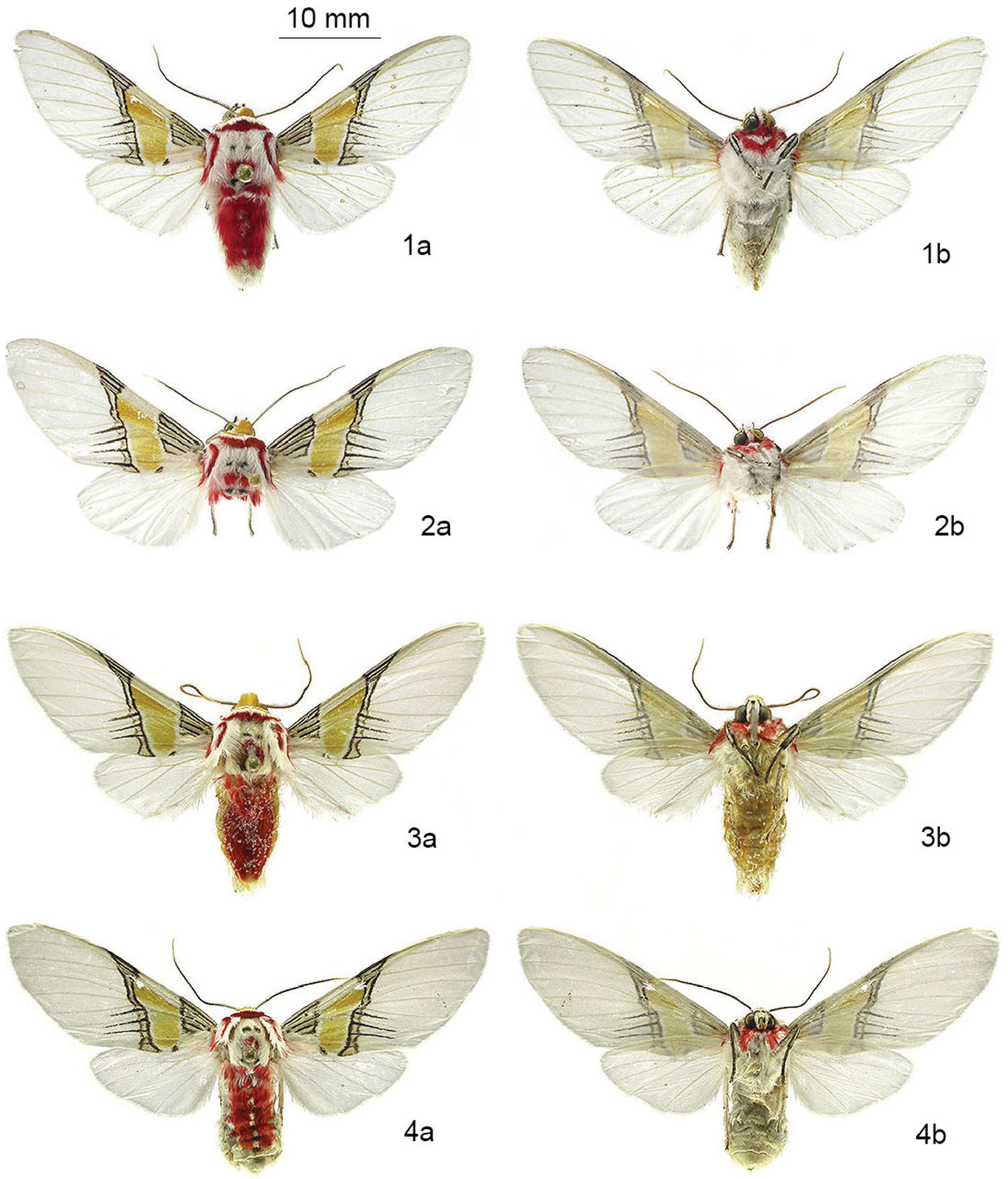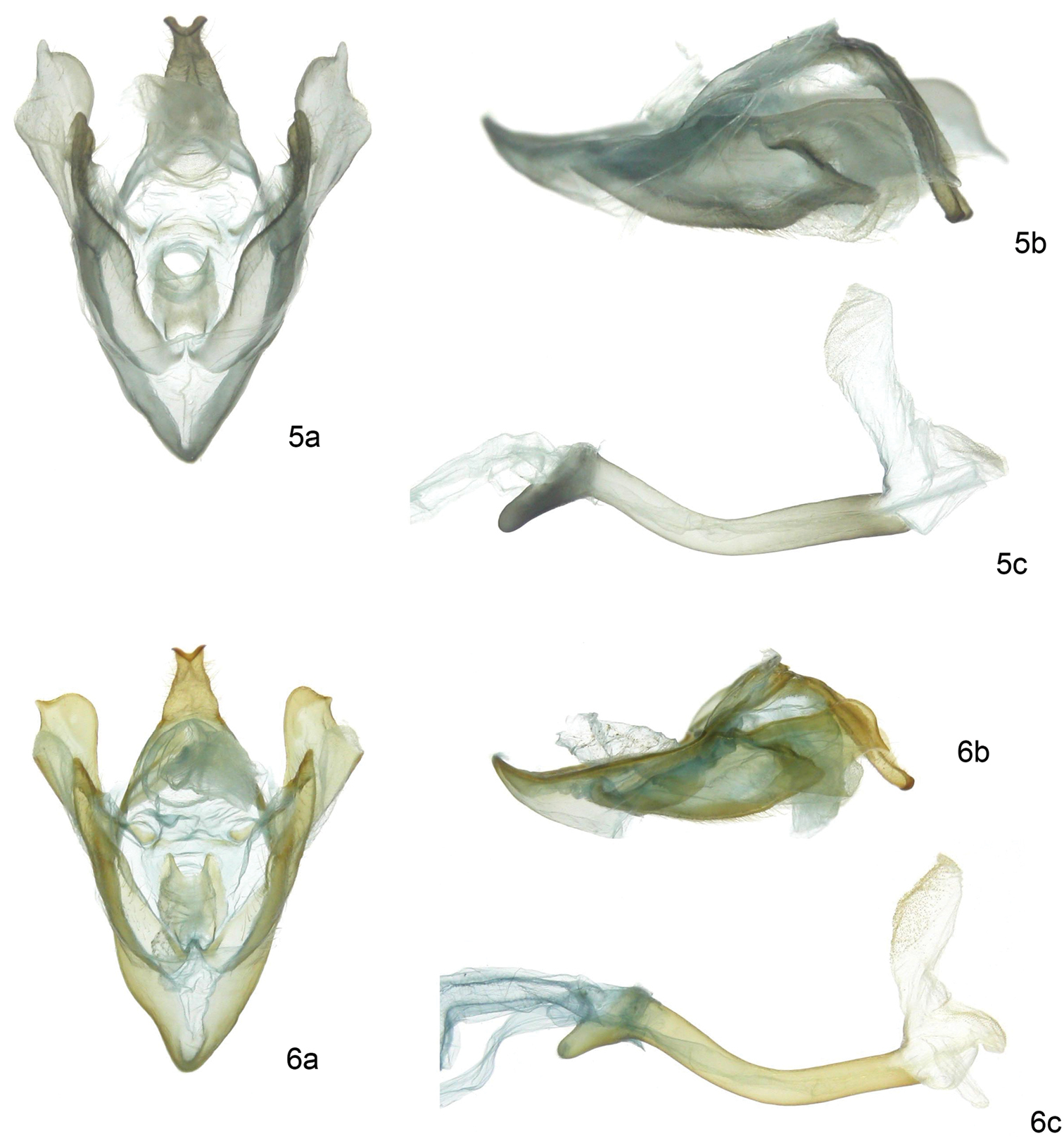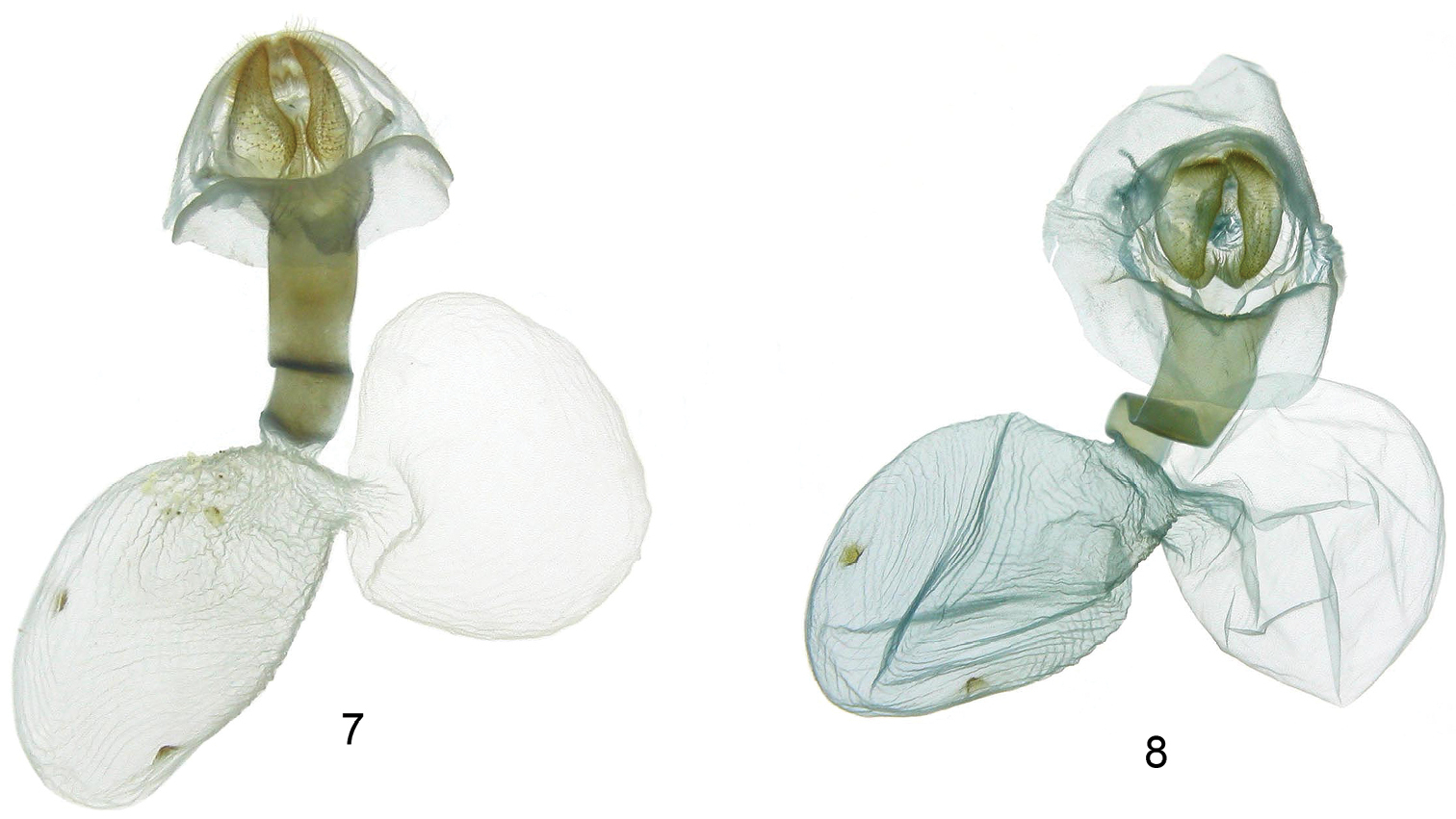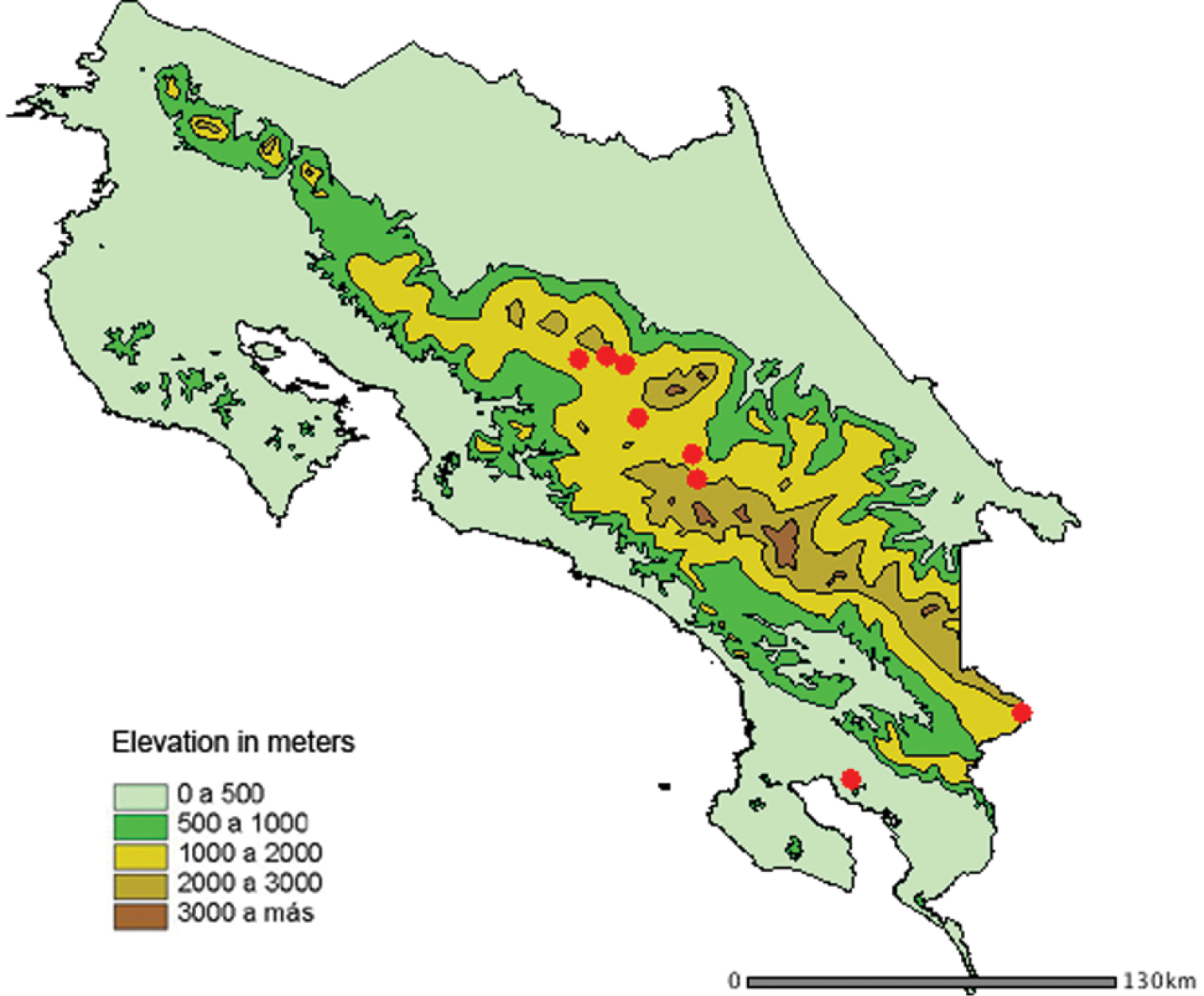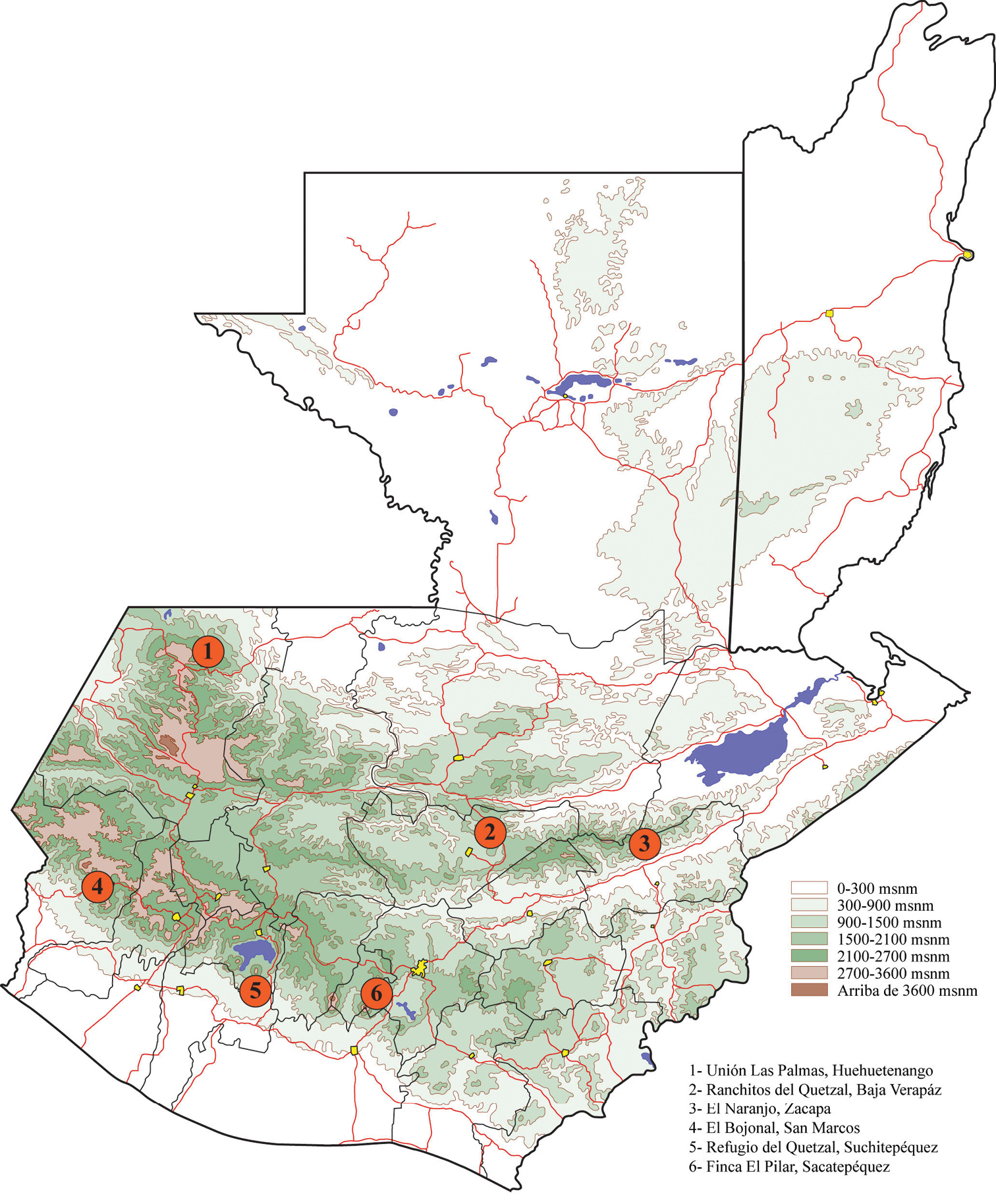






(C) 2013 Bernardo A. Espinoza. This is an open access article distributed under the terms of the Creative Commons Attribution License 3.0 (CC-BY), which permits unrestricted use, distribution, and reproduction in any medium, provided the original author and source are credited.
For reference, use of the paginated PDF or printed version of this article is recommended.
A new species and subspecies of Idalus Walker are described from Costa Rica, Honduras and Guatemala. Images of males and females and their genitalia are provided. Locality information and distribution maps for Costa Rica and for Guatemala are included. The biology and phylogeny of Idalus are discussed.
Lepidoptera, Erebidae, Arctiinae, Arctiini, Idalus paulae sp. n. , Idalus maesi faustinoi subsp. n. , Idalus maesi Laguerre , Myrtaceae, Costa Rica, Honduras, Guatemala
Walker (1855) described the genus Idalus based on the species Phalaena admirabilis Cramer from Surinam.
Genitalia were prepared following procedures detailed by
INBio Instituto Nacional de Biodiversidad, Heredia, Costa Rica
USNM Natural Museum of Natural History, Smithsonian Institution, Washing- ton D. C.
BMNH The Natural History Museum (formerly, the British Museum of Natural History), London, UK
MNHN Museum National d’ Histoire Naturelle, Paris, France
UVG Departamento de Biologia de la Universidad del Valle de Guatemala
JBS Personal collection of J. Bolling Sullivan, Beaufort, North Carolina
JMS Personal collection of Jose Monzon Sierra, Guatemala
ML Personal collection of Michel Laguerre, Bordeaux, France
urn:lsid:zoobank.org:act:4002FE75-D422-476C-92C1-4C43ED2466B0
http://species-id.net/wiki/Idalus_paulae
Figs 1, 2, 5, 7Holotype. ♂:COSTA RICA: Prov. Heredia, Santa Barbara, Finca La Kandela, 1400–1500m, 10.079°N, 84.159°W, 19–23.Oct.2011, leg. B. Espinoza; Trampa de Luz; Voucher # INB0004301794; GenBank accession # JX681671. [INBio].
9♂5♀ COSTA RICA: 1 ♂, Prov. Cartago, Tapantí, Río Grande de Orosi, 1300–1400m, 9.775°N, 83.796°W, 09.Apr.1984, leg. DH Janzen & W. Hallwachs; Voucher # INB0003455064, (dissected); 1 ♂, Prov. Puntarenas, Las Tablas, P. Internac. La Amistad, 1920 m, 8.949°N, 82.744°W, 13.Apr.1989, leg. G. Mora, M. Ramirez; Voucher # INBIOCRI000014399, (dissected); 1 ♂, Prov. Puntarenas, P.N. Piedras Blancas, Sector Riyito, 100m, 8.736°N, 83.288°W, 10.Sep.2002, leg. H. Mendez; Tp. de Luz; Voucher # INB0003536513; 1 ♂, Prov. S. José, P. N. Braulio Carrillo, Est. Zurqui, 500 m antes del Tunel, 1600m, 10.059°N, 84.012°W, 01.May.1991, leg. G. Maass; Voucher # INBIOCRI000358645; 2 ♂, Prov. Here, Res. Biol. Chompipe, C. Chompipe, 2100m, 10.088°N, 84.071°W, 9.Set.1991, leg. J. F. Corrales; Voucher # INBIOCRI000392944, INBIOCRI000392945; 1 ♂, Prov. Alajuela, La Paz Waterfall Gardens, alrededores del hotel. 1480m, 10.204°N, 84.167°W, 5–10.Aug.2007, leg. B. Espinoza; Tp. de Luz; Voucher # INB0004313093; 1 ♂, Prov. Cartago, La Unión. Z. P. C. Carpintera, Campo Esc. Istarú, 1750m, 9.891°N, 83.971°W, 16–17.Aug.2008, leg. R. Rojas; Tp. Luz Mercurio; Voucher # INB0004160698; GenBank accession # JX681685; 1 ♂, Prov. Heredia, Santa Barbara, Finca La Kandela, 1400–1500m, 10.079°N, 84.159°W, 19-23.Oct.2011, leg. B. Espinoza; Trampa de Luz; Voucher # INB0004301795; GenBank accession # JX681694; 1♂, Prov. San José, San Gerardo de Dota, QERC, 2230m, 9.619°N, 83.835°W, 16–27.Mar.2003, leg. J. B. Sullivan, J.D. Lafontaine; 1♀, Prov. San José, Par. Nac. Braulio Carrillo, Estación Zurquí (el Túnel), 1500m, 10.063°N, 84.011°W, 01.Oct.1985, leg. I. y A. Chacón; Voucher # INB0003506722; 1 ♀, Prov. San José, Par.Nac. Braulio Carrillo Estación Zurquí (el Túnel), 1500m, 10.063°N, 84.011°W, 9–11.Jun.1986, leg. I. y A. Chacón; Voucher # INB0003428272; 1♀, Prov. S. José, P. N. Braulio Carrillo, Est. Zurquí, 500 m antes del Tunel, 1600m, 10.059°N, 84.012°W, 01.May.1991, leg. G. Maass; Voucher # INBIOCRI000654190, (dissected); 1 ♀, Prov. Cartago, Paraíso, Pque Nal Tapantí, Sect La Represa, del Puente del Río Porras 300m SE, 1660m, 9.695°N, 83.781°W, 01.Jul.2002, leg. R. Delgado; Tp de Luz; Voucher # INB0003520571, (dissected); GenBank accession # JX681695. Paratypes deposited in INBio, BMNH, USNM, JBS.
This species is named for Ana Paula Zamora Espinoza, the author’s niece who has brought much happiness to her family.
This species can be recognized by the four dark-brown horizontal stripes on the medial area of forewings, between vein Cu1 and the posterior margin together with the yellow medial area (Figs 1, 2), uncus with a bifid and U-shaped terminus in dorsal view, valve with the saccular margin lobulated in the middle (Figs 5a, 5b) and by its distinctive DNA barcode.It is very similar to Idalus maesi faustinoi, which has only three dark brown horizontal stripes on postmedial area of forewing.
Adult male (Figs 1a, 1b, 5a, 5b, 5c). HEAD: Small head and large eyes; antennae serrate, base and antennae tip white, mid shaft brown; vertex slightly raised and hairy, yellow-orange; frons white with irregular mesial dark brown patch; labial palpi short and robust, upper half dark brown and lower half white; proboscis well developed. THORAX: Patagium white with red posterior edge and transverse yellow-orange band; tegula white, red laterally with a stripe curving inward extending from the base to the apex; thorax robust, white, with two small and elongate dark brown anterior patches, two large, red mid-dorsal patches and two small dark brown rounded patches on the posterior margin, ventrally white, hairy and with a red, longitudinal and ventrolateral stripe below the wings; anterior coxae striped with red. Forelegs white, femur dark brown on the proximal surface, tibia double striped with dark brown from base to tips, tarsal segments brown on the anterior surface; middle legs white, femur with a dark brown patch on tips, tibia double striped with dark brown on the proximal half, tarsi white with brown irregularly on posterior surface; hind legs white, a dark brown patch at the junction of the femur and tibia, tarsi white with irregular brown on posterior surface. ABDOMEN: White ground color, dorsally red between terga 1 and 7, basal segment with an irregular patch of long white hair and a series of small white dots between terga 3 and 7; white ventrally. WINGS: Forewing length 20.4 mm (n = 10). Semihyaline, white ground color, a creamy-white triangular basal patch edged with brown and with four fine dark brown longitudinal lines between the costal margin and the anal vein; a small brown spot in the postbasal area running to the posterior margin; medial area with a large yellow-orange patch between anal margin and R1; a fine transverse dark brown line goes from the anal margin toward the costal margin and turns medially on it; a second parallel fine line, straight from the costal margin to the vein Cu1, then undulating from below it to the anal margin; on the costal margin and between the transverse lines, two very fine dark brown lines between the costal vein and R1 and four more stripes, one between Cu1 and Cu2, two between Cu2 and the anal vein and one between the anal vein and the posterior margin. Hindwing semihyaline white, expanded in humeral area. GENITALIA (Figs 5a, b, c): uncus elongate, slightly flattened dorso-ventrally and with an acute shape distally, on its dorsum a thin, longitudinal mesial ridge arising from near the base and almost reaching the tip, terminus bifid and U-shaped in dorsal view and with an acute edge. Valve sclerotized, very wide at the base, acute and slightly concave at the apex and with the saccular margin lobulated in the middle; a large lobe arising distally from the outer surface with a straight costal margin, the saccular margin lobulated in the middle and with a small and acute projection at the tip. Juxta convex, very slightly sclerotized but not well defined; transtilla membranous and very slightly sclerotized at the base of valvae; saccus short and V-shaped; aedeagus long, thin, curved ventrally in the anterior part and curved dorsally in the distal part; vesica short, with two basal diverticuli, one small lateral diverticulum on the right side and another in front projecting slightly ventrally and spinulose, distal portion of vesica with a large spinulose patch. Adult female (Figs 2a, 2b, 7). HEAD: antennae serrate but less so compared to male antennae; sensillae less dense and shorter in length compared to males. THORAX: markings as in male. ABDOMEN: markings as in male, but more robust and rounded at the tip. WINGS: Slight sexual dimorphism, with the only differences being that the shape and size of the female wing (forewing length: 22.8 mm (n = 04)), is broader and longer than that of the male, and the wing apices of the females are more rounded than in the males. GENITALIA (Fig. 7): Anal papillae flattened laterally and rectangular in lateral view with a dense patch of short setae dorso-laterally; posterior apophysis 2.5 x as long as anterior apophysis; ostium sclerotized, very wide, dorsal margin rugose, ventral margin deeply concave and U-shaped; ductus bursae elongate, sclerotized and compressed dorsoventrally; corpus bursae oval, membranous and rugose with two small spiculate signa, one on each side the bursa; appendix bursa oval, slightly smaller than corpus bursa.
Adults of Idalus paulae sp. n. and Idalus maesi faustinoi subsp. n. a dorsal view, b ventral view. 1a, b Idalus paulae, sp. n., male holotype, INB0004301794 2a, b Idalus paulae sp. n., female paratype, INB0003520571 3a, b Idalus maesi faustinoi, subsp. n., male holotype, BAES000004 4a, b Idalus maesi faustinoi, subsp. n., female, BAES000012
Male genitalia of Idalus. a ventral view of genital capsule b lateral view of genital capsule c left lateral view of aedeagus 5a, b, c Idalus paulae, paratype, INBIOCRI000014399 6a, b, c Idalus maesi faustinoi, paratype, BAES000017
Female genitalia of Idalus. 7 Idalus paulae, paratype, INB0003520571, ventral view 8 Idalus maesi faustinoi, BAES000024, ventral view.
Idalus paulae has been collected between 1400 and 2230 m elevation in rain forest and the margins of cloud forest, on both Pacific and Atlantic slopes, from 1400 to 2230 m in the Cordillera Volcanica Central and the Cordillera de Talamanca of Costa Rica. There is a single specimen from the rain forest lowlands on the lowest slopes of the Cordillera Talamanca (100 m.) (Fig. 9). This is an unexpected locality but we are unable to find any differences between it and the remaining series of this species. Adults of Idalus paulae have been collected throughout the year but only in short series as the species is uncommon at lights and in light traps. No immature stages have been found but Idalus admirabilis, a related species, is known to feed on plants of the family Myrtaceae (
Distribution map of Idalus paulae sp. n. in Costa Rica.
http://species-id.net/wiki/Idalus_maesi_faustinoi
Figs 3, 4, 6, 8Holotype. ♂: GUATEMALA: Zacapa, San Lorenzo, El Naranjo, 1616m, 15.073°N, 89.685°W, 06.Jan.2010, leg. José Monzón; Voucher # BAES000004; GenBank accession # JX681678. [INBio]. Paratypes. GUATEMALA: 3♂, Zacapa, San Lorenzo, El Naranjo, 1616m, 15.073°N, 89.685°W, 06.Jan.2010, leg. José Monzón; Voucher # BAES000001, BAES000002, GenBank accession # JX681669; BAES000003, GenBank accession # JX681672; 7♂1♀, Suchitepequez, Santa Barbara, Ref. Quertzal UVG, 1600m, 14.542°N, 91.197°W, leg. Monzón y Camposeco; 1♂, 2010, Voucher # BAES000013; GenBank accession # JX681670; 1♀, 2010; Voucher # BAES000016; GenBank accession # JX681693; 1♂, 8.Feb.10, Voucher # BAES000014; GenBank accession # JX681691 (dissected); 5♂, 13.Jan.10, Voucher # BAES000017, GenBank accession # JX681681 (dissected); BAES000019, GenBank accession # JX681675 (dissected), BAES000020, GenBank accession # JX681677, BAES000021, GenBank accession # JX681687; BAES000018, GenBank accession # JX681667; 4♂2♀, San Marcos, Camino Fraternidad a Bojonal, 1600m, 14.946°N, 91.881°W, 12.Apr.2010, leg. José Monzón S.; 4♂, Voucher # BAES000007, GenBank accession # JX681698; BAES000008, GenBank accession # JX681683; BAES000009, GenBank accession # JX681665; BAES000010, GenBank accession # JX681676; 2♀, Voucher # BAES000011, GenBank accession # JX681674; BAES000012, GenBank accession # JX681682; 2♂, Huehuetenango, Barillas Unión Las Palmas, 1444m, 15.931°N, 91.299°W, 12.Apr.10, leg. Camposeco y Monzón; Voucher # BAES000005, GenBank accession # JX681689 (dissected); BAES000006, GenBank accession # JX681668. Additional material examined. HONDURAS: 1♀, Tegucigalpa, Cloud forest, 7000ft, 8.Aug.1972, leg. Robert D. Lehman; Black light (dissected). GUATEMALA: 9♂2♀, Suchitepequez, Santa Barbara Ref. Quertzal UVG, 1600m, 14.542°N, 91.197°W, leg. Monzón y Camposeco. 1♂, 13.Mar.2010, Voucher # BAES000022, GenBank accession # JX681690; 2♀, 13.Mar.2010, Voucher # BAES000023, GenBank accession # JX681696; BAES000024, GenBank accession # JX681697 (dissected); 1♂, 10.Apr.2010, Voucher # BAES000015, GenBank accession # JX681686; 2 ♂, 10.Sep.2007; 1♂, 01.Oct.2008; 1♂, 20.Sep.2009; 1♂, 15.Nov.2009; 2♂, 12.Dec.2009; 5♂2♀, San Marcos, Camino Fraternidad a Bojonal, 1600m, 14.946°N, 91.881°W, leg. José Monzón S. 2♂, 1♀, 27.Jul.2008; 1♀, 8.Aug.2008; 1♂, 6.Oct.2008; 2♂, 22.Sep.2009; 1♂, Huehuetenango, Barillas Unión Las Palmas, 1444m, 15.931°N, 91.299°W, 03.Sep.2010, leg. Camposeco y Monzón; 2♂, Baja Verapaz, Cerca Purulha, Hotel Ranchitos del Quetzal, 1656m, 13.Jul.2009, 15.216°N, 90.219°W, leg. Col. José Monzón S.; 1♀, Suchitepequez, Atitlan Reserve, 1570m, 14.328°N, 91.116°W, 9–10.May.2007, leg. M. Laguerre; Voucher # MILA.0407; Dissected, Gen. Voucher # MILA 1784; 1♂, Sacatepequez, San Cristobal el Bajo, Finca El Pilar, 1960m, 14.323°N, 90.422°W, 24.Jul.2004, leg. J.Haxaire & O.Paquit. Paratypes deposited in INBio, BMNH, USNH, UVG, JMS, ML, MNHN.
This subspecies is named after Faustino René Camposeco López, a field technician of the Universidad del Valle de Guatemala, who with José Monzón helped collect the type series.
This subspecies is closely related to Idalus paulae which has four dark-brown horizontal stripes on postmedial area of forewings but can be distinguished by the three dark brown horizontal stripes distal to the yellow median area, between vein Cu1 and the anal vein (Figs 3, 4), uncus with a bifid and V-shaped terminus in dorsal view, valve with the saccular margin very slightly lobulated in the middle (Figs 6a, 6b) and by its distinctive DNA barcode. From Idalus maesi maesi it is easily recognized by it maculation patterns, in Idalus maesi maesi the basal and medial area of forewings, as well as patagium are white, the thorax has no red mid-dorsal patches and the basal abdominal segments are white. DNA barcode of Idalus maesi maesi and Idalus maesi faustinoi differ by 0.65%.
Adult male (Figs 3a, 3b, 6a, 6b, 6c). HEAD: Head small and eyes large; antennae serrate, base and antenna tip white, mid shaft brown; vertex yellow-orange, slightly raised and hairy; frons white with irregular mesial dark brown patch; labial palpi short and robust, upper half dark brown and lower half white; proboscis well developed; THORAX: Patagium white with a red posterior edge and transverse yellow-orange band; tegula white, red laterally and with a stripe curving inward extending from the base to near the apex; thorax robust, white, with two small, elongated dark brown anterior patches, two large, red mid-dorsal patches and two small dark brown rounded patches on the posterior margin, ventrally white, hairy and with a red, longitudinal and ventrolateral stripe below the wings; anterior coxae striped with red. Forelegs white, femur dark brown on the proximal surface, tibia double striped with dark brown from base to tips, tarsal segments brown on the anterior surface; middle legs white, femur with a dark brown patch on tips, tibia double striped with dark brown on the proximal half and with a small dark brown patch on tips, tarsi white with brown irregularly on posterior surface; hind legs white, a dark brown patch at the junction of the femur and tibia and at the junction of the tibia with the tarsi, tarsi white with irregular brown on posterior surface. ABDOMEN: White ground color, dorsally red between terga 1 and 7, basal segment with an irregular patch of long white hair and a series of small white dots between terga 3 and 7; white ventrally. WINGS: Forewinglength 19.2 mm (n = 19). Semihyaline, white ground color, a creamy-white triangular basal patch edged with brown and with four fine dark brown longitudinal lines between the costal margin and the anal vein; a small brown spot in the postbasal area running to the posterior margin; medial area with a large yellow-orange patch between anal margin and R1; in the medial area, a fine transverse dark brown line goes from the anal margin toward the costal margin and turning medially on it; a second parallel fine line, straight from costal margin to the vein Cu1 and then undulating from below it to the anal margin; on the costal margin and between the transverse lines, two very fine dark brown lines between the costal vein and R1 and three more stripes, one between Cu1 and Cu2 and two between Cu2 and the anal vein. Hindwing semihyaline white, expanded in humeral area. GENITALIA (Figs 6a, b, c): uncus elongate, slightly flattened dorso-ventrally and acute distally, on its dorsum a thin, longitudinal mesial ridge arising from near the base and almost reaching the tip, terminus bifid and V-shaped in dorsal view and with acute edges. Valve sclerotized, very wide at the base, acute and slightly concave at the apex and the saccular margin very slightly lobulated in the middle; a large lobe arising distally from the outer surface with a straight costal margin, the saccular margin lobulated in the middle and with a very small, acute projection at the tip. Juxta convex, very slightly sclerotized but not well defined; transtilla membranous and very slightly sclerotized at the base of valvae; saccus short and V-shaped; aedeagus long, thin, curved downward ventrally in the anterior portion and upward dorsally in the distal part; vesica short, with two basal diverticuli, one small lateral diverticulum on the right side and another in front projecting slightly ventrally and spinulose, distal portion of the vesica with a large spinulose patch. Adult female (Figs 4a, 4b, 8). HEAD: antennae serrate but less so compared to male antennae; sensillae less dense and shorter in length compared to males. THORAX: markings as in male. ABDOMEN: markings as in male, but more robust and rounded at the tip. WINGS: Slight sexual dimorphism, with the only differences being that the shape and size of the female wing (forewing length: 22.2 mm (n = 5)), is broader and longer than that of the male, and the wing apices of the females are more rounded than in the males. GENITALIA (Fig. 8): Anal papillae flattened laterally and rectangular in lateral view with a dense patch of short setae dorso-laterally; posterior apophysis 2.5 x as long as anterior apophysis; ostium sclerotized, very wide, dorsal margin rugose, ventral margin deeply concave and V-shaped; ductus bursae elongate, sclerotized and compressed dorsoventrally; corpus bursae oval, membranous and rugose with two small spiculate signa, one on each side the bursa; appendix bursa oval, same size as corpus bursa.
In Guatemala (Fig. 10) Idalus maesi faustinoi is reported from cloud forest at 1444 to 1616 m elevation (José Monzón personal comm.). A single female specimen from Honduras, Tegucigalpa is recorded from cloud forest at 2133 m. Adults have been captured throughout the year. No immature stages have been found but Idalus admirabilis, a related species, is known to feed on Myrtaceae (
Distribution map of Idalus maesi faustinoi, subsp. n. in Guatemala.
The Arctiinae (formerly Arctiidae) are estimated to have 11, 000 species worldwide, with 6, 000 species in the Neotropics (
According to
Idalus paulae differs from Idalus maesi maesi and Idalus maesi faustinoi in DNA sequence of the CO1 locus by approximately 5%. Idalus maesi maesi and Idalus maesi faustinoi differ by at least 1% but Idalus maesi faustinoi breaks into two groups differing by 0.65%. Idalus maesi maesi clearly differs from Idalus paulae and Idalus maesi faustinoi in maculation (the median yellow area is white) but does not appear to differ in male and female genitalia (M. Laguerre, personal communication). Geographically, Idalus maesi maesi occurs in the mountains of northern and southern Pacific Nicaragua, Idalus paulae in the mountains of Costa Rica, and Idalus maesi faustinoi in the mountains of Honduras and Guatemala. The two distinct haplotype groupings of Idalus maesi faustinoi may represent two taxa but because they seem to have identical maculation and genitalia and because they do not sort geographically, we have chosen not to name both groups. Instead, the holotype and paratypes are based on populations from the northern montane slopes in Guatemala. It will take additional studies to resolve the haplotype distributions and to establish the food plants upon which this group feeds.
We have not tried to establish morphological characters that separate the maesi group from the other three Idalus groups. However, we have noticed that in the maesi group, sexual modifications of scales and venation in the area of wing overlap are absent but present in those species we have examined from the other three groups. The humeral area is lobed but that character applies to most Arctiinae. The small differences in the CO1 sequences between Idalus maesi maesi and Idalus maesi faustinoi may reflect recent and rapid evolution of these species in the complex montane regions of Central America.
We thank the ACG parataxonomists for finding and rearing the caterpillars of Idalus, and light-trapping adults. We thank Michel Laguerre and Benoit Vincent for dissections and information provided from their personal collections; José Monzón, Jack C. Schuster, Enio B. Cano, Faustino Camposeco and the Departamento de Biología de la Universidad del Valle de Guatemala for the specimens from Guatemala that are included in this revision as well as CONAP for collecting and research permits in that country. We are indebted to the USNM for the loan of the specimen from Honduras, and to the Instituto Nacional de Biodiversidad (INBio) for the information, office and collection space, and specimens provided, to Carolina Garro Morales for reading and correcting to the manuscript, and finally to our colleagues Eugenie Phillips, Isidro Chacón and Ronald Zuñiga for their encouragement and support. This study was supported by Jessie Hill, the JRS Biodiversity Foundation, the Wedge Foundation, the Genome Canada, and NSF BS&I DEB 0515699 to D.H. Janzen.
